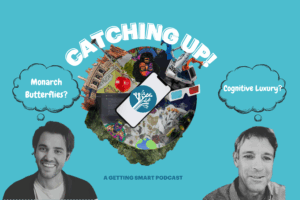10 Things the Human Resources Department Should Do to Advance Next-Gen Learning

As the learning landscape continues to change for students, teachers, and administrators, it creates new challenges and opportunities for school districts and network support services, especially Human Resources (HR). Next generation learning, which is blended, personalized, and competency-based, requires new skills, new roles and a new mindset for educators.
Leading comprehensive talent development requires HR departments to create strong partnerships with school leaders and their supervisors, with preparation programs, and with technology vendors. Following are the 10 things that HR departments should do to foster next-gen learning.
1. Update hiring profiles. Teacher and leader profiles ought to reflect the knowledge, skills and dispositions needed to teach and lead in an increasingly blended and personalized environment. Given how profound the changes are, a detailed suite of qualifications are much more helpful than traditional position descriptions. For example, see the iNACOL Blended Learning Teacher Competency Framework.
Summit Public Schools provides a great example of a competency map that includes four levels of expertise (ranging from basic to expert) across seven dimensions of effective teaching (for example content, assessment, use of data and technology). Teachers demonstrate, and supervisors and peers assess competencies using multiple observations and data sources.
In addition to hiring, gaining clarity on what teachers and leaders should know and be able to do creates a common vision for professional development and classroom observations.
2. Demand that preparation programs deliver competence. Share your teacher profile with other districts and networks and attempt to build support for a common description of quality preparation. Take the profile to leading preparation programs and tell them your district won’t hire teachers unless they match the profile.
Incorporate the profile in the teacher hiring process. Use it to draft questions. Ask candidates to model a next-gen lesson during the interview.
3. Develop a systematic method of talent identification. There are hundreds of thousands of teachers off and running, using the digital resources they can find, and they’re encouraging students to do the same. School and system heads need to figure out what’s actually going on in classrooms and how to leverage teacher leadership to build and accelerate the digital conversion. (See upcoming paper “Preparing Leaders for Deeper Learning” from Getting Smart and Digital Promise that will launch in May.)
Fulton County identified four teachers in each school and offered them training and networking opportunities. CityBridge trains teacher leaders in Washington DC.
Working with school leaders and supervisors, HR departments should develop a systematic way to identify and maintain a roster of talented teachers with leadership potential. An HR information system should help.
4. Create a lattice of developmental roles. Blended school models create new roles like multi-classroom leadership. OpportunityCulture from Public Impact identifies several new roles and opportunities to use technology to leverage great teaching. (See New Staffing Structures Piloted in Nashville Schools.)
Houston created leadership opportunities so that teachers who want to stay in the classroom do not have to move into administration, but instead can lead capacity-building processes in areas of instructional technology, assessment and other initiatives. Such opportunities, along with a reputation for innovation and rewarding good performance, have led to a 90 percent teacher retention rate.
Converting traditional schools to next-gen learning involves many projects, time bound initiatives with specific deliverables. Teacher leaders can serve on or lead project teams. It creates a cost effective staffing solution and valuable leadership development opportunities.
We use the term lattice (rather than career ladder) to denote a varied sometimes nonlinear career progression of jobs and project leadership opportunities that provide a breadth of experiences. According to MaryEllen Elia, Hillsborough Florida superintendents have been, “Purposeful in creating wide range of experiences for leaders – it really helps.”
5. Shift to competency-based development. A system that supports competency-based development begins with a map that outlines what you need to know, different ways to learn it, and a variety of ways to show what you know. Those three ingredients, as outlined in
Preparing Teachers For Deeper Learning are key for any form of competency-based development, whether talking about student learning to any form of job training. (As mentioned, watch for the leadership sequel next month.)
A robust system will have various iterations of a map outlining what educators need to know to be able to do, which may vary based on level, role, environment, and more. The different ways of learning can be formal and informal, online or blended, on-demand or scheduled, self-sought or part of a systematic program.
The competency map and career interests should drive an individual development plan that includes learning goals for the current role and a career goal. The plan should be powered by online resources on a platform like Bloomboard.
To envision a competency-based development system in action, imagine if each time a teacher leader is assigned a project management role, they could receive a digital playlist of learning experiences to support their new role (both content knowledge and process skills) and an experienced mentor to provide real time support and guide reflective learning. A relevant sequence of supported projects would be far more valuable than a masters degree, and better preparation for being a principal than conducting student discipline as an assistant principal.
6. Create a team of next-gen learning school model experts. Most school leaders will need help developing new school models. HR should convene and develop a team of people (internal and external) who will become the go-to experts on how to develop and staff next-gen school models. This team will identify needs and hiring criteria, ensuring the right roles and the right people to support next-gen learning.
This team should include HR professionals and blended learning coaches that consult with principals on blended learning models and related staffing options available to them. Depending on the needs of the school, the work of the team may range from consultative (providing expert outside advice on how to change staffing requirements) to prescriptive (outlining a plan to ensure improved results).
7. Provide tiered support. A system of earned autonomy and tiered support focuses district resources where they’re most needed and gives high performing schools autonomy to design innovative learning experiences.
A tiered accountability system would allow a phased shift to personalized learning by allowing top performing schools to select a blended model and staffing structure independently, and enjoy more hiring autonomy. Low performing schools receive more directed support in staffing structures and hiring.
8. Improve employee relations with better service and systems. Strong employee relations are a key component of strong community (and voter) relations. Whether seeking to meet daily needs such as managing benefits, payroll, and easy access to web-based forms, HR professionals have an opportunity to deliver on promises and build trust as they serve employees. In doing so, they will foster happy constituents who will also be the best advocates for the district. Delight both employees and the community with progress toward your vision.
Renee Hill, of Riverside USD (featured in the Talent Development chapter of Smart Cities) suggests that delighting internal customers is more than a friendly attitude, it’s striving for great solutions. Renee said, “Now, we iterate. Start, check, modify, restart or continue, repeat. There is no time to fully develop solutions. We operate in outline form, draft outline form, even. Outline a plan and get busy!”
9. Build a better hiring bargain. When doing the above things, HR professionals and hiring managers can offer a great hiring bargain to new employees. Something like, “We offer the kind of teaching you want to do, more rapid advancement opportunities than most districts, great growth opportunities and competitive pay.”
Districts and networks can work with the local chamber to meet the needs of new teachers, including pursuing support for housing stipends where needed.
Houston ISD Superintendent Terry Grier said they seek to improve internal talent through recruitment, opportunity and reward. They recruit often and early through partnerships with universities and Teach for America. Grier and his team turned that around with the largest TFA partnership in the country by offering big signing bonuses and by marketing the opportunity. They made visible changes at each school and invited candidate teachers to visit and talk to students who could attest to the turnaround underway.
10. Craft better agreements. Schools are social institutions, the health of which depends on the many and varied agreements crafted among stakeholders. When it comes to employment and role agreements, HR has an important job, including the responsibility to shape better agreements that are suited for next-gen learning.
District, network and school leaders should help teams operate at high levels under existing conditions and periodically reshape those conditions for the benefit of students. Reshaping conditions requires stakeholder conversations that create a shared vision and a series of agreements that keep a school community moving forward.
Stretch role. Leading this talent development agenda can be a stretch for a previously transactional HR department. It requires a partnership with school leaders and their supervisors, with preparation programs, and most importantly with employee groups.
In addition to being a stretch for HR professionals, HR information systems aren’t up to this task list. Building an HRIS that promotes blended, personalized, and competency-based professional growth is a big impact opportunity.
HR departments need the full support of their superintendent and board. They need the opportunity to learn from organizations with well developed talent development strategies. If the community includes some well run organizations, a community advisory board on talent development could be helpful.
The most important shift is a change in mindset from compliance transactions to a system wide (even citywide according to Terry Grier) view of talent development. HR can’t do it alone but they can create partnerships that exert a big sphere of influence on the development of teaching talent.
See also:
- Agreement Crafting: 10 Lessons on the Politics of Schooling
- Preparing Teachers for Deeper Learning blog and paper
- Leadership Development in US Schools: The Opposite of Good
- How Smart Cities Develop Teachers & Leaders
- Leading with Teacher Innovation
 Tom Vander Ark is founder and CEO of Getting Smart. He is also a partner in Learn Capital and a director of iNACOL, Digital Learning Institute, Imagination Foundation, Charter Board Partners, Strive for College, and Bloomboard.
Tom Vander Ark is founder and CEO of Getting Smart. He is also a partner in Learn Capital and a director of iNACOL, Digital Learning Institute, Imagination Foundation, Charter Board Partners, Strive for College, and Bloomboard.





Tom Vander Ark
Great related read on Reinventing Performance Management
https://hbr.org/2015/04/reinventing-performance-management